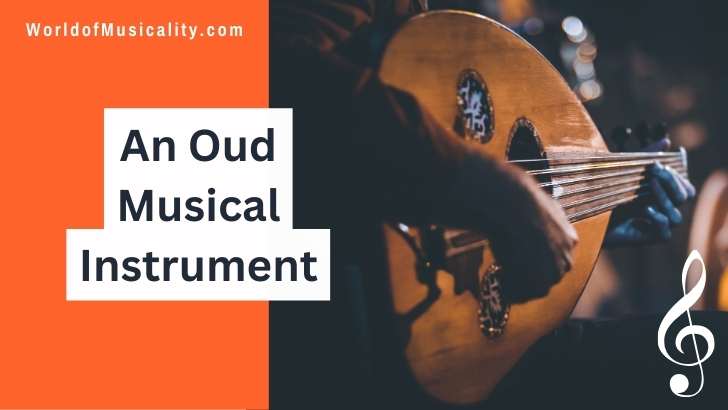
What is an Oud Musical Instrument?
The oud is a pear-shaped stringed instrument typically made from wood. With a large hollow body and a short neck without frets, it is widely used in Middle Eastern and North African music. It has a deep, resonant sound, played with a plectrum, and typically features 11 to 13 strings grouped in pairs. The oud is a key instrument in traditional and contemporary Arabic music.
In this introductory guide, we’ll address the question of what an Oud musical instrument is by by examining what it sounds like, how it’s played, its long history, its popularity, how its made, and also explore some of the great tunes and compositions it has produced.
Oud Instrument Facts
- The oud is one of the oldest stringed instruments, with origins dating back thousands of years.
- A person who plays the oud is called an “oudist.”
- It typically weighs between 0.7 to 1.5 kilograms, making it relatively lightweight and easy to hold.
- The dimensions of an oud vary, but it generally measures about 650mm in length with a width of 370mm.
- On the Hornbostel–Sachs classification system, it is classified as a chordophone because it produces sound through vibrating strings stretched between two points.
- The strings were traditionally made of gut but are now more commonly made of nylon or metal.
- The most expensive ouds are handcrafted by skilled luthiers, and their prices can exceed tens of thousands of dollars due to materials, craftsmanship, and historical value.
- Turkish and Arabic ouds differ slightly in size, string tuning, and sound, catering to regional musical styles.
- The oud has inspired Western composers and can be heard in various classical and contemporary Western music pieces.
- Famous oud players include Farid El Atrache, Munir Bashir, and Naseer Shamma, who have contributed significantly to the instrument’s global recognition.
- The oud plays a central role in traditional ensembles called Takht, foundational to classical Arab music.
How Popular is the Oud?
Now that we have examined some interesting facts about the instrument, lets see how popular the oud is across the world.
Using Google Search Trends as an indicator of interst and popularity, we can see that the oud is highly popular within many Middle Eastern countries and North Africa.
What does an Oud Instrument Sound Like?
The oud produces a rich, resonant sound with deep, warm tones and a wide expressive range, ideal for conveying the nuanced melodies of Middle Eastern music. For a closer look and to experience the captivating sound of the oud, watch this video below.
How to Play the Oud Instrument
The oud is played with a plectrum, traditionally made from an eagle’s quill or plastic in modern times, which the player uses to pluck or strum the strings. This technique allows for a range of expressive dynamics, from delicate, whisper-soft notes to powerful, resonant tones.
Sound is generated when the player strikes the strings with the plectrum, causing them to vibrate. These vibrations transfer through the bridge—a small piece of wood that supports the strings above the body—to the soundboard, a larger wooden surface that amplifies the sound within the hollow body of the instrument.
The shape and construction of the oud’s body are crucial to its sound production, with the curved back helping to project the sound outward.
The strings of the oud, typically made of nylon or gut, are arranged in courses of two, with the exception of the lowest (or highest in pitch) string, which is often single.
Players can alter the sound by varying the plucking technique, including the strength of the pluck, the use of upstrokes or downstrokes, and the point along the string where they pluck. By manipulating these variables, oudists can produce a wide palette of sounds, from bright and clear melodies to deep, resonating bass notes.
Mastering the oud requires a deep understanding of the instrument’s mechanics, as well as the intricate modal systems of Middle Eastern music.
The Oud Instrument Description
Each component of the oud is meticulously crafted, with the choice of materials significantly influencing the instrument’s final sound. Here’s a closer look at the essential components of the oud and the materials commonly used in its making.
Body
The body forms the main resonant chamber of the oud, where sound is amplified. It is traditionally made from strips of wood called ribs, glued together to create a rounded, pear-shaped back. Various woods are used for the body, including walnut, rosewood, and maple, each offering distinct acoustic properties. Walnut provides a warm tone, rosewood enhances the instrument’s resonance and depth, while maple offers a brighter sound.
Soundboard
The soundboard is the flat surface on the front of the oud’s body, crucial for sound projection. Spruce and cedar are popular choices for the soundboard; spruce delivers clarity and brightness, whereas cedar offers a richer, warmer sound. The soundboard also features one or more sound holes, often intricately decorated with a wooden rosette.
Neck
The neck of the oud is typically made from hardwood such as mahogany or walnut, known for their strength and stability. It extends from the body and supports the fingerboard, though unlike many Western stringed instruments, the oud’s neck does not contain frets.
Fingerboard
The fingerboard lies on top of the neck and is where the player presses down the strings to change pitches. Ebony is a favored material for the fingerboard due to its durability and smooth texture, allowing for ease of play.
Pegbox and Tuning Pegs
The pegbox is an extension of the neck, housing the tuning pegs. These pegs are made from hardwoods like ebony or rosewood. Their function is to hold the strings in place and adjust their tension for tuning. The tuning pegs’ design can vary, affecting both the instrument’s aesthetic and the ease of tuning.
Bridge
Positioned on the soundboard, the bridge transfers the vibrations from the strings to the soundboard. It is usually made from hardwood such as maple or rosewood, chosen for their ability to convey sound efficiently.
Strings
Originally, oud strings were made from gut, but today, nylon and metal strings are more commonly used. Nylon strings produce a soft, warm tone, while metal strings, often silver-plated copper, offer a brighter sound with more sustain.
Different Types of Oud Instrument to Learn
There are several types of oud instruments, each offering unique characteristics and sounds that cater to different musical styles and preferences. Below is a list of these variations, along with a brief overview of their pros and cons.
Arabic Oud
- Pros: Features a deep, round sound ideal for traditional Arabic music; widely available and taught.
- Cons: Might be challenging for beginners due to its size and string tension.
Turkish Oud
- Pros: Slightly smaller and has a brighter sound, suitable for both classical and contemporary Turkish music.
- Cons: The higher pitch and tension can require more precise finger technique.
Persian Oud (Barbat)
- Pros: Offers a distinct, crisp sound with a wider range, fitting for Persian classical music.
- Cons: Less common outside of Iran, which can make it harder to find instruments and teachers.
Iraqi Oud
- Pros: Known for its mellow tone and floating bridge, allowing for unique vibrato effects.
- Cons: The floating bridge design might be difficult for beginners to adjust to.
Egyptian Oud
- Pros: Larger in size, providing a robust and resonant sound suitable for a variety of musical styles.
- Cons: Its size may make it less comfortable for players with smaller hands.
Syrian Oud
- Pros: Often highly ornate, producing a warm and rich sound prized in classical Arab music.
- Cons: High-quality Syrian ouds can be expensive due to craftsmanship and decoration.
Greek Oud
- Pros: Adapted for Greek music, offering a sound that bridges Middle Eastern and Western styles.
- Cons: Might not be as suitable for purely traditional Middle Eastern music due to its tonal adjustments.
Each type of oud presents its own learning curve and requires dedication to master, but all share the ability to convey a wide range of emotional expressions through music.
Musical Origins of the Oud
The name “oud” originates from the Arabic word “al-‘ūd” (العود), which translates to “the wood” or “the stick.” This term reflects the instrument’s construction from wooden pieces and signifies its evolution from simpler, ancient stringed instruments.
The oud’s name and design were adopted and adapted across different cultures, leading to variations in name and form, such as the European “lute.”
The table below outlines the ouds journey from ancient Persian times through to its highly prominent place in modern popular and traditional music.
| Time Period | Development |
|---|---|
| Ancient Times | Origins trace back to ancient Persia, evolving from earlier stringed instruments. |
| 7th-9th Centuries | Spread across the Islamic world during the Islamic Golden Age, influencing musical practices. |
| 11th Century | Introduction to Europe, likely through Spain, influencing the development of the lute. |
| 16th-17th Centuries | Became central to Arabic music, with significant refinements in design and tuning. |
| 18th-19th Centuries | Further development in the Ottoman Empire, leading to variations like the Turkish and Armenian ouds. |
| 20th Century | Revival and modernization, including the incorporation of new materials and electronic amplification. |
| 21st Century | Global popularity, with use in various music genres beyond traditional Middle Eastern music. |
Significant Oud Players
The oud, an instrument with a profound legacy, has been shaped by numerous skilled musicians whose artistry has elevated its stature in global music traditions. These players, hailing from diverse backgrounds and eras, have each left a unique stamp on the musical world through their mastery of the instrument.
Below are five renowned oud musicians, recognized for their significant contributions and the enduring impact of their work.
Farid El Atrache (1910–1974)
Born in Syria and raised in Egypt, Farid El Atrache became a legendary figure in Arabic music as a singer, composer, and oud player. His innovative approach to the oud and his ability to blend it seamlessly with his vocal performances made him a beloved figure across the Arabic-speaking world.
Munir Bashir (1930–1997)
An Iraqi musician, Munir Bashir was revered for his extraordinary talent and was dubbed the “King of the Oud.” His instrumental virtuosity and profound musical interpretations helped to introduce the oud to a global audience, influencing countless musicians.
Naseer Shamma (born 1963)
From Iraq, Naseer Shamma is acclaimed for his virtuosic playing and innovative compositions. Shamma’s ability to convey deep emotional narratives through the oud has made him a prominent figure in contemporary Arabic music and a respected teacher and musicologist.
Simon Shaheen (born 1955)
A Palestinian-American, Simon Shaheen has played a pivotal role in merging Arabic musical traditions with jazz and Western classical music. His virtuosity on the oud and violin and his dedication to education have significantly contributed to the instrument’s popularity in the West.
Marcel Khalife (born 1950)
Lebanese composer and oud player Marcel Khalife is known for his revolutionary approach to Arabic music. Through his compositions and performances, Khalife has addressed themes of love, peace, and resistance, making him a symbol of artistic freedom and innovation.
Significant Oud Music
The oud, a central instrument in Middle Eastern music, captivates with its deep, resonant tones, playing a pivotal role in both traditional and contemporary compositions.
Here are five traditional tunes and compositions that exemplify the oud’s beauty and the depth of its musical expression.
1. “Taqsim Nahawand” by Riad Al Sunbati
- Composer: Riad Al Sunbati
- Date: Mid-20th century
- A solo improvisation in the Nahawand maqam, this piece showcases the oud’s capacity for emotional depth and nuance, reflecting Al Sunbati’s mastery in blending traditional Arabic music with modern sensibilities.
2. “Samai Bayati Al Aryan” by Tatyos Efendi
- Composer: Tatyos Efendi
- Date: Late 19th century
- This Samai, a classical Ottoman instrumental form, is known for its elegant structure and rhythm, highlighting the oud’s lyrical qualities within a sophisticated compositional framework.
3. “Longa Riad” by Riad Al Sunbati
- Composer: Riad Al Sunbati
- Date: 20th century
- Another exemplary work by Al Sunbati, “Longa Riad” is celebrated for its lively tempo and intricate melodic lines, offering listeners a vibrant showcase of the oud’s versatility and expressive potential.
4. “Leih Ya Banafseg” by Sayed Darwish
- Composer: Sayed Darwish
- Date: Early 20th century
- A piece that combines poignant lyrics with captivating melodies, this composition reflects Darwish’s influence on modern Arabic music and the oud’s role in conveying emotional depth.
5. “Improvisation in Maqam Kurd” by Munir Bashir
- Composer: Munir Bashir
- Date: Mid-20th century
- Munir Bashir, known as the master of the oud, uses this improvisation to explore the maqam Kurd, demonstrating the instrument’s dynamic range and the emotional intensity it can evoke.
The Oud in Popular Culture
The oud, with its distinctive sound, has additionally transcended its traditional Middle Eastern roots to find a place in popular culture, films, TV, and even rock music, capturing the imagination of a global audience.
Here are five more compositions where the oud plays a pivotal role, demonstrating its appeal beyond its traditional context.
1. “The Feeling Begins” by Peter Gabriel
- Composer: Peter Gabriel
- Album: Passion (1989)
- Used in the soundtrack for “The Last Temptation of Christ,” this piece features the oud prominently, creating a haunting and evocative atmosphere that sets the tone for the film.
2. “Mediterranean Sundance/Rio Ancho” by Al Di Meola, Paco de Lucía, and John McLaughlin
- Composers: Al Di Meola and Paco de Lucía
- Album: Friday Night in San Francisco (1981)
- This live acoustic track, while primarily a showcase for flamenco guitar, incorporates elements reminiscent of the oud’s sound, blending Eastern and Western musical traditions in a virtuosic performance.
3. “Ys” by Alan Stivell
- Composer: Alan Stivell
- Album: Ys (1976)
- A landmark in Breton folk music, this album includes tracks where the oud is used to add depth and a touch of Middle Eastern mystique to the Celtic soundscapes, showcasing its adaptability across genres.
4. “Eastern Promises” by Howard Shore
- Composer: Howard Shore
- Film: Eastern Promises (2007)
- The soundtrack of this film features the oud to evoke the Eastern European and Middle Eastern themes central to the movie’s plot, highlighting its ability to convey mood and cultural context.
3. “Habibi” by Tamino
- Artist: Tamino
- Album: Amir (2018)
- Belgian-Egyptian singer Tamino incorporates the oud in his debut album, blending its traditional sound with modern indie and alternative influences. The song “Habibi” showcases the oud’s emotive power, underlining Tamino’s haunting vocals and the track’s atmospheric depth.
Instruments Similar to an Oud
By answering the questions “What is an Oud instrument”, we hope to have sparked your interest in this amazing and very ancient musical instrument.
If you are keen to learn more about some other very similar instruments here are five more we think you might find intersting.
Lute
Originating in Europe during the Middle Ages, the lute is descended from the oud, introduced by Arab musicians. With a rounded back and a fretted neck, the lute produces a softer, more resonant sound, and was a central instrument in European classical music.
Saz
The saz, or bağlama, is a long-necked lute from Turkey, crucial to Anatolian folk music. It has a bright, twangy sound, with three main strings (or courses), and is played with a pick, offering a distinctive melodic expression.
Bouzouki
A mainstay of Greek music, the bouzouki is a long-necked lute with a sharp, metallic sound. Originally from the Byzantine Empire, it has evolved into a vital part of Greek folk and rebetiko music, featuring a flat back and steel strings.
Pipa
The pipa is a four-stringed Chinese lute with a pear-shaped body, tracing back over two thousand years. Known for its expressive bends and vibrato, the pipa plays a significant role in Chinese classical and folk music, showcasing a wide range of techniques and sounds.
Tanbur
Predominantly found in Persian, Kurdish, and Turkish music, the tanbur is a long-necked lute known for its deep, meditative sound. It is traditionally used in spiritual and ceremonial music, with a body made from a single piece of wood and three to six strings.






